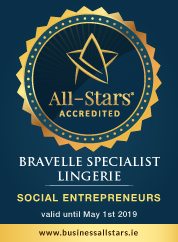News / April 10, 2012
See the artical below from Lingerie Buyer magazine, who accompanied us on our trip.
The Centres of Excellence scheme is the baby of Jemma Barnes, Anita UK’s general manager. When she joined the company 18 months ago there was no training programme for the UK and Ireland, and she wanted to create a recognised course that would give the end consumer confidence in the service they receive from retailers, and breast care nurses confidence in where to send their patients.
The training has been running since 2010, and already there is a waiting list. There are 12 retailers on this trip, with businesses that vary from department stores to specialist shops and even a medical supplies company. They are Katherine and Pauline Conway from Bravelle, in Limerick, Ireland………As well as giving retailers the opportunity to familiarise themselves with Anita’s products and fitting techniques, the training is an essential element of Anita’s aim to improve the service available to women who have had breast surgery.
The two days of the trip are structured to show retailers not only the latest products but how they are made and how the business is run…..This is a huge operation, and it would be easy for a company of this size to appear impersonal and remote, but the rest of the trip quickly dispels any such notion. When Anita’s Anni Osarogie talks about what makes Anita unique, she explains its core principle – to help any woman find the right bra and feel special whether that is a Care bra, a maternity bra, something for larger cups or just a pretty, comfortable bra. We want to have the best product for our customers and we always want to improve what we do, so we encourage feedback. We see any problems as a chance for us to do
something better and this makes us stronger.’
And indeed Anni sits through the subsequent training sessions with education manager Beate Raupach, recording comments and any requests for new products. She is also on hand to explain why sometimes things are not possible, or that the product is already in development.
Beate is in charge of training on these trips, and covers the latest mastectomy lingerie and swimwear products, prostheses and fi tting techniques. She is helped by models,
Elfi and Rosi, both women who have undergone surgery for breast cancer and have been working with Anita to demonstrate its products for ten years and more.
While Elfi and Rosie model the Care styles, Beate explains their construction and benefits to give the retailers a thorough understanding of the new bras they will be selling, and any changes to products already in stock. As Beate passes round examples of different components, it’s the little details that stand out. Underwires that look bent have in fact been made deliberately uneven to fit the body’s contours, and the body side of the wire is rounded so that it rolls with movement. Moulded cups have hidden
side slings built in for extra support, made from a special material that prevents them from yellowing over time.
What else stands out as the day goes on is the care gap between hospitals and retailers. Some of the women on the trip have been through breast surgery themselves, and all are working with women everyday who are dealing with the after effects of breast cancer. These can vary significantly, and it’s emotional just hearing about the problems women can face. That some could be eased by something as simple as a well designed and fitted bra and prosthesis, and yet aren’t for so many women, is sobering.
Price and quality is a subject that keeps coming up. Anita bras are not cheap, but neither are they elaborately designed with decorative details and yards of beautiful lace. Anita’s quality is all in the details. That’s not to say that the company does not produce pretty lingerie, just that aesthetics, in the specialist product areas at least, have to work around performance and function.
About 30 percent of the company’s business is in the sale of full and partial breast forms, and over the two days we have a chance to not only learn about and handle the latest products, and practice fitting them, but also see the manufacture of the prostheses in action – a process that is largely done by hand with a minimum of
automation and a lot of dedicated attention to detail.
First are the product demos, and to illustrate just how far technology has advanced, Beate passes round examples of prostheses from up to 40 years ago. Heavy, cumbersome and uncomfortable even to look at – some are rubber, others filled with, of all things, wallpaper paste – these old breast forms are a million miles from the silicone products currently available to women.
Anita produces a wide range of full and partial forms, Stephan Volk, who heads up the facility, talks us through the materials and the exacting process of production. Even
with skilled and practised workers, making prostheses is not quick – each step can take time, from two days to make an initial mould, to half an hour to make the film,
and an hour and a half to bake the prostheses after they have been filled. They are then cleaned and trimmed by hand, before each and every one is quality inspected.
This final tour in many ways sums up what the whole trip has been about – a deepening of understanding not just bout the products and the brand, but the little things that make such a difference. This is such a sensitive rea, and each individual’s requirements can be so different, hat really knowing what you are doing and what you areselling is so important. And that’s what it means to becomean Anita Care Centre of Excellence.




